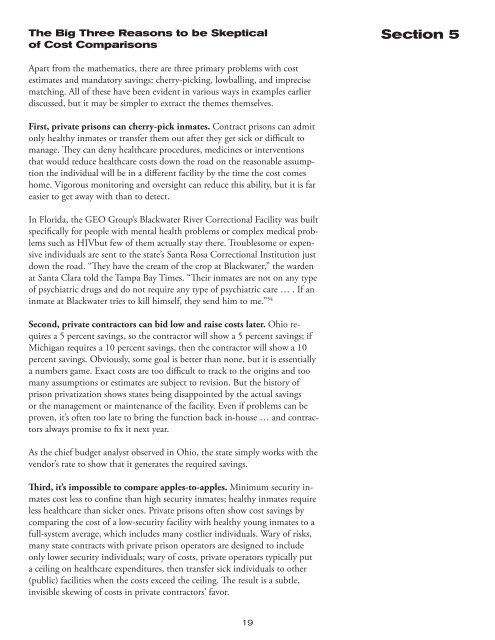Pitfalls and Promises - Michigan Corrections Organization
Pitfalls and Promises - Michigan Corrections Organization
Pitfalls and Promises - Michigan Corrections Organization
You also want an ePaper? Increase the reach of your titles
YUMPU automatically turns print PDFs into web optimized ePapers that Google loves.
The Big Three Reasons to be Skepticalof Cost ComparisonsSection 5Apart from the mathematics, there are three primary problems with costestimates <strong>and</strong> m<strong>and</strong>atory savings: cherry-picking, lowballing, <strong>and</strong> imprecisematching. All of these have been evident in various ways in examples earlierdiscussed, but it may be simpler to extract the themes themselves.First, private prisons can cherry-pick inmates. Contract prisons can admitonly healthy inmates or transfer them out after they get sick or difficult tomanage. They can deny healthcare procedures, medicines or interventionsthat would reduce healthcare costs down the road on the reasonable assumptionthe individual will be in a different facility by the time the cost comeshome. Vigorous monitoring <strong>and</strong> oversight can reduce this ability, but it is fareasier to get away with than to detect.In Florida, the GEO Group’s Blackwater River Correctional Facility was builtspecifically for people with mental health problems or complex medical problemssuch as HIVbut few of them actually stay there. Troublesome or expensiveindividuals are sent to the state’s Santa Rosa Correctional Institution justdown the road. “They have the cream of the crop at Blackwater,” the wardenat Santa Clara told the Tampa Bay Times. “Their inmates are not on any typeof psychiatric drugs <strong>and</strong> do not require any type of psychiatric care … . If aninmate at Blackwater tries to kill himself, they send him to me.” 54Second, private contractors can bid low <strong>and</strong> raise costs later. Ohio requiresa 5 percent savings, so the contractor will show a 5 percent savings; if<strong>Michigan</strong> requires a 10 percent savings, then the contractor will show a 10percent savings. Obviously, some goal is better than none, but it is essentiallya numbers game. Exact costs are too difficult to track to the origins <strong>and</strong> toomany assumptions or estimates are subject to revision. But the history ofprison privatization shows states being disappointed by the actual savingsor the management or maintenance of the facility. Even if problems can beproven, it’s often too late to bring the function back in-house … <strong>and</strong> contractorsalways promise to fix it next year.As the chief budget analyst observed in Ohio, the state simply works with thevendor’s rate to show that it generates the required savings.Third, it’s impossible to compare apples-to-apples. Minimum security inmatescost less to confine than high security inmates; healthy inmates requireless healthcare than sicker ones. Private prisons often show cost savings bycomparing the cost of a low-security facility with healthy young inmates to afull-system average, which includes many costlier individuals. Wary of risks,many state contracts with private prison operators are designed to includeonly lower security individuals; wary of costs, private operators typically puta ceiling on healthcare expenditures, then transfer sick individuals to other(public) facilities when the costs exceed the ceiling. The result is a subtle,invisible skewing of costs in private contractors’ favor.19












